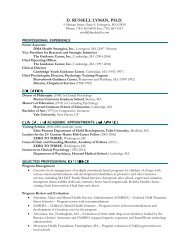Commonwealth of Massachusetts - DMA Health Strategies
Commonwealth of Massachusetts - DMA Health Strategies
Commonwealth of Massachusetts - DMA Health Strategies
- No tags were found...
You also want an ePaper? Increase the reach of your titles
YUMPU automatically turns print PDFs into web optimized ePapers that Google loves.
Brandeis University and other experts has involved analyzing integrated data to define outcomes, trackprogress in treatment, and develop predictive measures. Interagency data sharing efforts (ESM, HMIS) will bedramatically assisted by data system enhancements resulting from single entry <strong>of</strong> invoices across services andagencies. Outpatient redesign is underway with a focus on training in evidence-based practices and usingperformance measures in service procurement, supported by active participation in Purchase <strong>of</strong> Service andChapter 257 activities. BSAS has achieved a fully staffed licensing unit with revised regulations aimed atimproving quality and accountability. Two new physicians are providing medical consultation to the Bureau.6. Reducing the high cost <strong>of</strong> incarceration and recidivism on both the criminal justice and treatmentsystems by promoting recovery and returning people to productive lives.DYS is engaged in assuring that all youth in the agency’s custody are appropriately screened and that thosewho need treatment receive it. DYS has joined an interagency agreement to increase its residential substanceuse and addictions treatment capacity.An interagency review team has standardized Section 35 evaluations and increased Section 35 casemanagement for 18 to 25 year olds. Two new adult drug courts are supported by technical assistance andannual site visits. The corrections system has benefited from funding for substance use and addictionspositions in all eight Parole Re-Entry Centers, and funding to 13 Houses <strong>of</strong> Corrections provides substanceuse and addictions services to 2,300 admissions per year.A Substance Abuse Strategic Plan for the Next Five YearsThe Changing EnvironmentThe 2005 Plan has altered the state environment by bringing many agencies and disciplines together, reducingthe “silos” in which all have typically operated. In addition, the entire health care environment in<strong>Massachusetts</strong> has changed dramatically over the past few years, and will continue to do so. <strong>Health</strong> carereform has been implemented in <strong>Massachusetts</strong> and federal health care legislation has been passed; mentalhealth parity requirements now also cover addiction treatment; an economic downturn has undercut thestate’s ability to fund services; and the <strong>Commonwealth</strong>’s procurement strategies are in the process <strong>of</strong> beingsignificantly modified. Together, these dramatic changes are having and will continue to have an impact thatwill change the role the <strong>Commonwealth</strong> plays in addressing substance use and addictions among its residents.The now widespread understanding <strong>of</strong> addiction as a chronic medical condition, along with the evolvinghealthcare environment, require that careful thought be given to how <strong>Massachusetts</strong> can best develop a fullcontinuum <strong>of</strong> prevention, intervention, treatment and recovery supports that are known to be effective.<strong>Health</strong> Care Reform and Parity requirements<strong>Massachusetts</strong>’ landmark 2006 <strong>Health</strong> Care Reform Law, together with the 2000 <strong>Massachusetts</strong> Mental<strong>Health</strong> Parity Act and its recent update, set the stage for numerous changes with regard to how substance useand addictions services are paid for. The 2006 law established a requirement that all residents purchase healthinsurance, with the result that an estimated 97percent <strong>of</strong> the population now has some form <strong>of</strong> coverage. 44 “Since the Connector’s inception, the state’s uninsured rate has dropped from 10.4 percent in 2006 to 2.6 percent in 2008. . .”http://www.stateline.org/live/details/story?contentId=425028.Substance Abuse Strategic Plan Update Page 4July 2010





